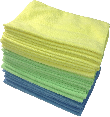Cleaning Paint Off of Fiberglass
Written by Lee Wyatt (last updated October 28, 2024)
Fiberglass is perhaps one of the most utilized materials in the home today. This versatile material can be found in just about any bathroom, work room, or kitchen in almost any home. As such you can find just about any type of stain, such as paint, on it at any given time. Luckily, cleaning paint off of fiberglass isn't that difficult to do as long as you follow the proper steps.
- Check to see if it is a stain. Before you can actually begin cleaning paint off of fiberglass, you need to double check and ensure that it really is a stain. Many times fiberglass will age and discolor over time. This can end up looking like a paint stain, when it is in fact not. Often this will appear as an area that is a different shade of the same color as the rest of your fiberglass surface. If the "stained" area is actually a completely different color, or you happened to see the paint spill, then you will need to proceed with stripping the paint from your fiberglass.
- Which technique will you use? There are primarily two methods that you can use for removing paint from a fiberglass surface. One method is to utilize chemicals that have been designed to penetrate the enamel that could be included in the paint. If you use this method, be sure that you carefully read the instructions, and provide plenty of ventilation prior to starting. The second, and often quicker, method for removing paint from fiberglass is to use abrasives. One example would be to use sand paper, or if the surface is large enough use a sandblaster.
- Utilize your method. Utilize whichever method you decided upon to begin removing the stain. Be aware that you will need to be particularly careful when using an abrasive method since you could potentially damage the fiberglass that is underneath the paint. Whichever method you decided to utilize just be sure that you begin by starting in an inconspicuous location in case there is any accidental damage.
- Clean up, and reseal. Upon removing the stain, clean up the mess that was left behind. Be sure that you completely, and thoroughly, clean the area that you just worked on. This will ensure that you do not leave anything behind accidentally which could create difficulties when resealing or repainting. Purchase and apply some sealer and paint if necessary. Apply these according to the manufacturer's directions, and then clean up once again. You are now finished.
Author Bio
Lee Wyatt
Contributor of numerous Tips.Net articles, Lee Wyatt is quickly becoming a regular "Jack of all trades." He is currently an independent contractor specializing in writing and editing. Contact him today for all of your writing and editing needs! Click here to contact. Learn more about Lee...
Restoring Antique Porcelain Plates
Antique porcelain plates are a beautiful investment that no one really wants to see go to waste. Over time, these plates ...
Discover More
Dealing with Pet Accidents
No matter how well trained your pet is, there are still going to be times when an accident happens. This means that if ...
Discover More
Choosing Energy Efficient Light Bulbs
It is becoming more and more popular to make the home as energy efficient as possible. One of the more common methods ...
Discover More
Removing Deodorant Stains
To remove pesky deodorant stains, first try a stain-removal product and liquid laundry detergent along with regular ...
Discover More
Removing Sweat Stains
When you discover a sweat stain on your shirt, turn the shirt inside out and rub plain white vinegar into the stain. You ...
Discover More
Removing Paint Stains
Paint stains are best treated while still wet. For watercolors and latex paints, just pre-treat the stain with stain ...
Discover More

Comments